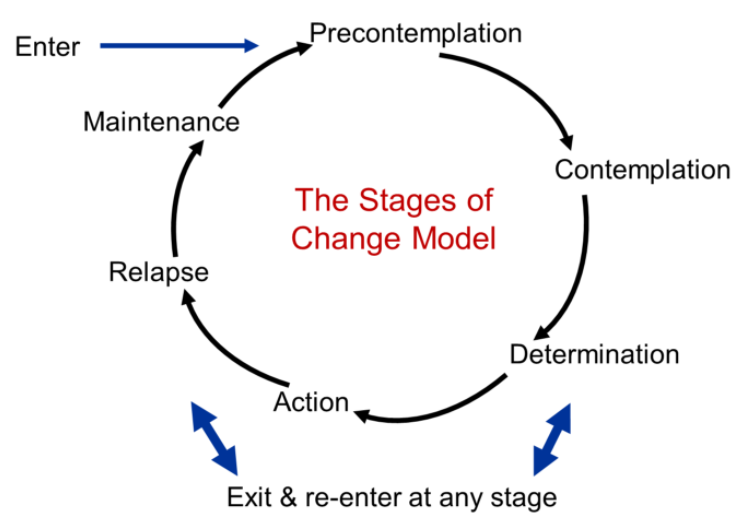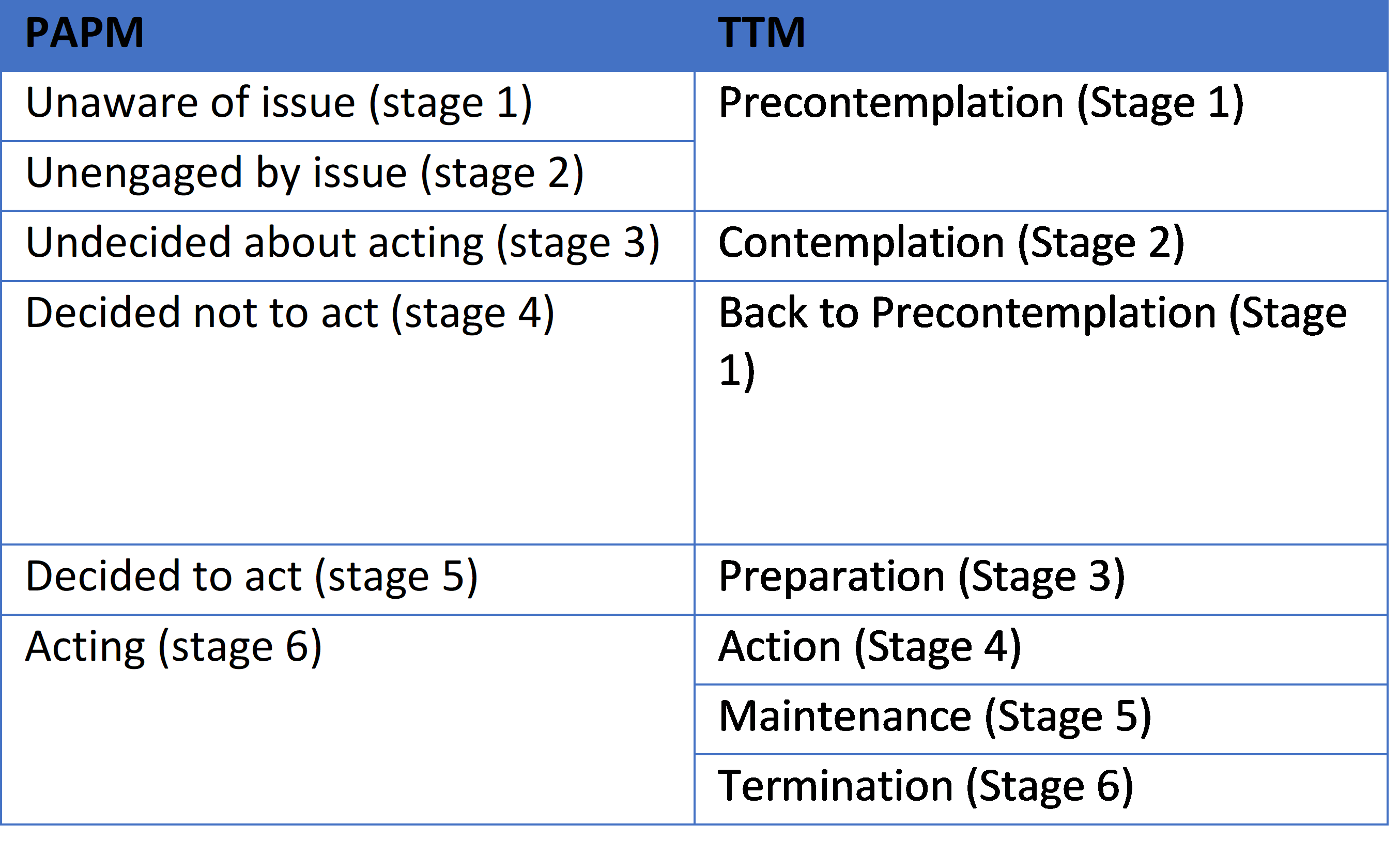Part 2: The Message
2.3.2 Wake Up: Precaution Advocacy as a Tool to Motivate Behavior Change
Learning Objectives
- To argue for why the precaution adoption process model (PAPM) is helpful in dealing with situations where people are not acting to reduce a hazard.
- To provide examples of how the PAPM can be used to develop risk messages.
- To discuss barriers to moving between the stages of the PAPM and ways to overcome those barriers.

Precaution adoption process model (PAPM)
This model describes how people progress from being unaware of an issue to being aware of it and acting appropriately. The diagram below describes the seven stages of the model and the factors that govern the transitions from stage to stage. Remember that people can move both forward and backwards between certain stages and may become ‘stuck’ at a particular stage.


Supplementary Material
A Tale of Two Models by Yinghong (Amy) Wu
How do people take action? Is it as simple as going from point A to point B, or are there more complex stages in between?
Health Promotion Models are used to explain behaviors to guide people to better health. Two such models that I’ve come across are the Precaution Adoption Process Model (PAPM) highlighted in Module 4, along with the Transtheoretical Model (TTM) taught during my dietetic internship.
The Precaution Adoption Process Model is used when it is desirable for people to act to reduce a hazard, and shows the stages in which people move from being unaware about an issue to making a decision about an action to taking action.
The Transtheoretical Model, also known as “Stages of Change”, has decision-making as it’s focus as well, and models intentional change or action.
The six stages include:
- Precontemplation – People are not aware that their behaviour can lead to negative consequences, or feel that the effort of making a change is not worth the benefits that it would yield. There is no desire to make a change.
- Contemplation – People acknowledge that their current behaviour could be problematic, and intend to start a healthy behaviour in the foreseeable future. However, they may still feel ambivalent about making changes.
- Preparation (Determination) – People start to take small steps in planning to take action to better health
- Action – People are actively changing their behaviour, and intend to continue with the change.
- Maintenance – People have continued their new behaviour for more than 6 months, and intend to sustain it going forward. They work to prevent relapse to prior stages.
- Termination – There is no desire to return to previous unhealthy behaviours. hey have no desire to return to previous unhealthy behaviours. This stage is rarely reached, and is often not a consideration in health promotion programs,

Both models have 6 stages, but their progression along the decision-making continuum varies:

PAPM places heavier emphasis on the earlier stages of being unaware and unengaged by the issue, and acknowledges that people may decide not to act despite having considered the issue. TTM focuses on the latter stages of behaviour change in action, maintenance, and termination. While TTM posits that people can exit and enter at any stage, PAPM suggests that from stage three, the person decides not to take action and ends at stage 4, or decides to take action and continues onto stage 5.
Both models are used to help understand complex behaviours, and allow for different theories to be applied at the different stages. However, PAPM’s intended application is for understanding how people make decisions to take action, not for the long-term development of health habits. TTM has been used in helping individuals establish long-lasting health behaviours.
Models help make some sense of complex human behaviours, but rarely is it one-model-fits-all. It can be helpful to be familiar with various models and theories so that they may be utilized strategically in the unique circumstances that you will encounter in your career as a public health communicator!
Using the PAPM
- Define what the different stages are.
- Determine what your goal is (i.e., to move everyone to action, or just to move them one stage ahead of where they currently are).
- Determine who your target group is (i.e., are they defined by personal characteristics but they all exist at different stages of the PAPM, or are they all at a specific stage but otherwise are a diverse group?).
- Determine how you will classify individuals according to their current stage.
- Identify the factors that will influence transition among the different stages, as well as factors that could cause stagnation or regression.
- Identify the tools that will help to achieve your desired stage transitions. Remember that the tools you use will need to be tailored to your audience, to their position on the PAPM, and to the change you are trying to achieve. If you are mismatched then you will annoy people, confuse them, or lose their attention. This means that the greater the range of stages, the more difficult it is choose a single message or tool.
- Determine how you will evaluate whether your program has been effective at achieving your goal.
Example
When to use the PAPM
The PAPM can be used to understand the psychological process of adopting or stopping a behaviour. Advocates of this type of stage theory say that changes in behaviour are too complex to be described by a single equation and must therefore be explained by a series of equations (i.e., a series of moves between stages). The PAPM can be applied to understanding how people come to make a decision to take action. It should not be applied to the gradual development of habits or to spontaneous actions that were not planned.
Example
Tools to moving between stages
According to Weinstein, Sandman & Blalock (2008), the media often can have a major influence in getting people from Stage 1 of the PAPM to Stage 2 and from Stage 2 to Stage 3 but has much less influence from there. Theories of health behaviour, like the Health Belief Model and the Theory of Reasoned Action, can be used to understand how people who get to Stage 3 make a decision (move to Stage 4 or 5). From there, understanding the risks, outcomes, experiences, motivations, and barriers at each stage can help you to determine how to get people to go from decision to action, and from action to maintenance. Below is a table of some tools and factors that can affect transition between the stages.
| Transition | Factor/Tool |
| Stage 1–2 |
|
| Stage 2–3 |
|
| Stage 3–4/5 |
|
| Stage 5–6 |
|
Barriers to moving between stages
Confirmation bias
People tend to adhere to previously held beliefs. The degree to which your messaging aligns to those beliefs will influence how easily you can transition people between stages. There is not much you can do about this other than to be aware of it and use the other tools we discuss in this text to try and work through it. It is important to highlight the problematic nature of Stage 4 at this point. This is where confirmation bias is at its height. Most people in this category appear to be well informed but only accept information that aligns with their bias, finding reasons to reject any evidence to the contrary. This is a very unique stage that is fundamentally different from Stage 3 (people who are not acting because they are undecided).
Example
A group that may be influenced by confirmation bias is people who are anti-vaccination. In many cases, these people have made up their mind (Stage 4) and are unwilling to accept any information that contradicts their views. This is distinct from those who are vaccine hesitant, who would be placed in Stage 3 of the PAPM based on their being undecided or skeptical about vaccination.
Stage paralysis
If you are asking people to make a difficult decision or do something challenging, then they may get stuck. This is why it is important to actually show them how to easily transition from one stage to another. For example, if you are asking people to test for radon, you might provide links to places where they can purchase a testing unit online. A detailed implementation plan can often be the key to transitioning people from decision to action. This plan should include concrete targets that are meaningful to, and achievable by, your target audience.
Perceived susceptibility
This basically captures the fact that most people think they are invincible. In general, people more readily accept the risk posed to others compared to the risk posed to themselves. This is why information must be presented to your target audience in a manner that maximizes its relevancy and accessibility.
Example
An example of the perceived susceptibility barrier is people who do not get the flu vaccine because they do not believe that they are at risk of developing severe symptoms from the flu. While there are additional dimensions related to vaccination decisions, ignoring or misunderstanding the risk from communicable disease is a barrier to action (vaccination) related to perceived susceptibility.
Barriers to action
It is important to be aware of and work to overcome barriers to action. Barriers could be related to cost (i.e., are you advocating for an action that is prohibitively expensive or too time consuming?), access (i.e., is it something that is more geographically accessible to some than others?), and any number of other factors that can hinder a person’s ability to engage with the action. This is where you must consider alternative measures to improve likelihood of action.
Complex problems or actions
As stated, the PAPM works best for very simple problems and behaviours (i.e., getting vaccinated, testing for radon, etc.). More complex issues may require a more nuanced application of the PAPM. For example, if you want people to be more active, then you might choose to present people with a menu of actions versus something specific. It may be easier to get people to decide to do something versus a specific thing, but this could backfire if your recommendations are so vague that people don’t really know what to do.
Takeaways
Key Takeaways
Key takeaways for the precaution adoption process model (PAPM):
- The PAPM aims to explain how a person comes to decisions to take action and how they translate that decision into action.
- The PAPM can be applied to many simple behaviour changes but may not be suitable for more complex changes.
- It is important to understand where your target group lies in the model, the barriers at each stage of change, and the tools available to facilitate that change.
Media Attributions
- The Precaution Adoption Process Model © Adapted from Health Behavior and Health Education
- Fig 2.1.2.1 JBLM PAO 151005-N-TF029-002 © Joint Base Lewis McChord is licensed under a CC BY-NC-SA (Attribution NonCommercial ShareAlike) license
- Fig 2.1.2.2 086 Radon – Periodic Table of Elements © Science Activism is licensed under a CC BY (Attribution) license



